|
Since man first began to trade with others of his kind he has looked upon the rivers, lakes and fjords of Western Lýthia and Hârn through
which flows the economic life blood of these regions; grain, fur, wine, luxury goods and many more commodities desired by all levels of society. Without
these vital trade routes, economic prosperity and the growth civilizations would have been severely constrained. Instead of thriving civilizations and
kingdoms, nothing more than a collection of petty tribal groups would exist. It is along these vital highways that the region's economic prosperity has
blossomed; however, these routes are also traveled by armies, religions, technologies and political ideas. Like the arteries of the human body, they
have become obstructed from time to time. Wars can impede the flow of trade and intellectual knowledge, but allow the free flow of new tactics,
technologies and political ideas. As a civilization grows, its mere presence can create barriers such as bridges, mills, weirs and various other manmade
features. As far as trade and the flow of goods, the imposition of tolls and various other duties along these routes poses the biggest impediment. No
matter the barrier, man has always found a way to circumvent them. New trade routes are found to bypass war torn areas and burdensome tolls and new
technologies are developed to overcome manmade barriers. No mater the problems encountered, the means for navigating these waterways has not changed for
centuries; listed are some of the most common types of vessels found within the regions of Northwestern Lýthia and Hârn:
|
|
Vessels From Pilot's Almanac
|
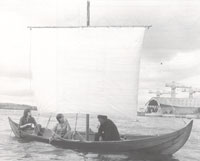
|
Pinda:
A small, deckless boat, equipped with oars; the larger Pindas also carry a small mast. In the waters of Northwestern Lýthia and
Hârn the rigging is traditionally square-rigged; areas to the south and east normally carry venyn-rigged sails. Although these vessels
are know primarily as ship's boats for larger vessels on the open seas, within the inland waterways they act as fishing vessels, transports
and all around utility vessels within and around the civilized trade centers and settlement. Pindas range in size from 12 feet to 21 feet;
the largest carrying no more than 5 tuns of goods and crew.
|
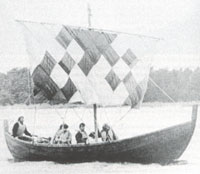
|
Talbar:
A true inland water vessel, the Talbar is beamy and shallow drafted; it was specifically designed to transport trade goods upon the region's
rivers, lakes, fjords and shallow coastal waters. The design is well know throughout western Lýthia; however, each region has its
variations. Within the regions of Northwestern Lýthia and Hârn it is constructed in clinker fashion and has many Ivinian
characteristics due to that nation's shipwrights influence; whereas, in the southern and eastern regions of Western Lýthia it is
constructed in the caravel fashion and favors Azeryani influences. Most vessels operating on western rivers are just under 30 feet in length
to escape the piloting restrictions imposed by the Pilot's Guild upon all maritime traffic within most larger settlements. A key feature
that differentiates the Talbar from Niviks is its wider beam to length ration which enables it to carry larger cargo than its draft would
normally allow. The vessel are equipped with both oars and a mast; square rigged in the west and north and venyn-rigged in the south and
east. The mast is stepable and easily lowered or raised to allow the vessel to pass under bridges and other obstructions. Talbars range in
size from 24 feet to 42 feet and can carry up to 34 tuns of goods and crew on the largest types. The larger Talbars are used primarily as
coastal luggers and many have a small covered shelter at the rear of the vessel for the crew.
|
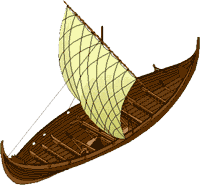
|
Nivik:
This is the largest vessel to be found traveling beyond the tidal basins of all but the smallest rivers; on the larger systems an occasional
Dak or Karune may also be seen. See 'Sea Trade Lanes' for a full description of the Nivik.
|
| |
|
|
A New Vessel For Northwest Lýthia
|
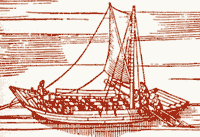
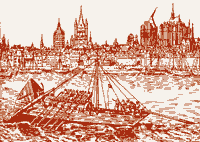
|
Barge:
A flat-bottomed vessel equipped with oars and a mast; within Northwestern Lýthian and Hârn they are square-rigged and venyn-
rigged with in the southern and eastern parts of Lýthia. The bottom of the vessel is constructed of flush-laided planks, the larger
ones having up to six bottom planks. The outer plank on each side are L-shaped and have the side strakes mounted in clinker fashion. The
rear of the vessel is squared off with the strakes fastened to a transom. The bow of the vessel is either pointed, tying into a built in
stem post; or it flat like the aft and also tying into a transom. Most may have aft and/or fore decks for the crew with the center section
being for cargo. Although they can be powered by oars or sail, many of these vessels are towed up stream using human or animal power. In
civilized regions, rivers and canals used by these vessels will also have well used paths alongside them for the draftsmen or animals to
walk. Likewise, many settlements along these routes have small holders who service specific stretches of a river or canal as draftsmen,
providing animals or themselves as the means of moving barges along the waterway. Like the Talbar, the barge's design is well know
throughout western Lýthia. It is constructed predominantly in clinker fashion; however, in the southern and eastern regions of
Western Lýthia it is also constructed in the caravel fashion. Most of these vessels are just under 30 feet in length to also escape
the piloting restrictions, just like the Talbar The vessel's flat bottom allows it to work in rather shallow waters and enables it to move
over obstructions and underwater obstacles much easier than a round bottomed or keeled vessel. When oars are used, they are mounted in the
fore section of the vessel. The vessel is controlled by a large steering oar hung over the rear of the vessel. Barges can range in size from
15 feet to 45 feet and carry loads well over 40 tuns.
|
| |
|
|
Primitive Vessels Used Throughout Western Lýthia
|
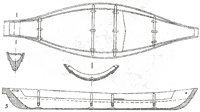
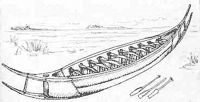
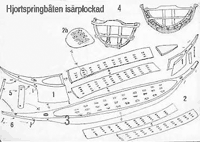
|
Log Boat:
These vessels have been around before recorded history. They are the vessel of the poor peasants, tribal groups and others living near
bodies of water. These vessels are primarily used for a variety of utilitarian purposes; to include, fishing and transport. The basic vessel
is nothing more than a hollowed out log with rounded or flat ends. This is the most common form found throughout Hârn and Northwestern
Lýthia.
However, over time men have devised other means to enable these crafts to have broader beams and more depth than the log itself may allow.
In the first case the builder would not remove the top portion of the log, but hollow out the log leaving this as an upper lip. Once the log
was hollowed out the log would be placed by a fire and hot rocks would also be placed inside it to soft the wood and allow the lip and sides
to be spread out using braces. Once the desired beam was achieved, permanent braced would be installed and the vessel completed. This is a
common form found in Hurisea and adjacent areas.
A more advanced form that involves adding a bow, stern and sides onto the vessel in a clinker fashion. Sometimes they are sewn on as in the
ancient fashion or attached using iron clench nails. This form is commonly found throughout the region of Altland.
|
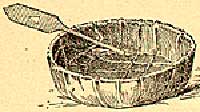


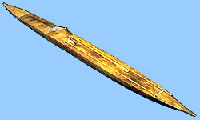


|
Skin Boat:
Like the log boat, skin boats have also been around before recorded history. These are very crude vessels constructed of wickerwork shell
and skins sewn over it. The simplest form is a hemispherical shell, like an upside down turtle shell. A more complicated form is in the
shape of a boat and up to 16 feet in length. These first two examples are found throughout northern Lýthia and among the tribal
groups of Hârn.
The Yarili of Ivinia build and use an enclosed form with pointed ends and has small openings where goods and people are loaded and from
where the vessel is controlled using paddles.
|
|